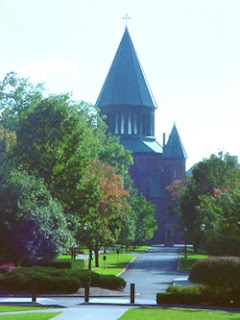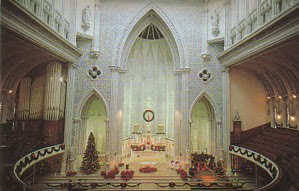Few experiences have impacted me as much as having participated in five
Great Races. The “Great Race” is a precision endurance rally that has gone across the country every year since 1983. For many years it was restricted to about 100 antique automobiles. Four times – 1998, 2001, 2002, and 2004, I drove my 1932 Plymouth Model PB business coupe. In 2006, I drove a 1936 Buick Century sedan. Every time has been a remarkable view of this great country from its back roads.
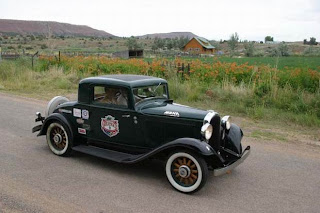 It all started in 1996 with a phone call from a long-time friend and associate, Bob King, who asked if I would like to restore my long-neglected Plymouth and go on the Great Race with him as my navigator. After discussing the idea with Margo, I embarked on a 2-year restoration project leading to the 1998 rally. The rally started in Tacoma, Washington, and ended near Boston, in Haverhill, Massachusetts two weeks later. The car had less than 100 miles on the rebuilt drive train when we started, but ran flawlessly over the 4,500-mile route. We had a minor blizzard in Colorado, a flat tire in Kansas, and got lost several times (Each car receives its route instructions 10 minutes before departing each morning.), but enjoyed an unforgettable trip. Obviously it got in my blood.
It all started in 1996 with a phone call from a long-time friend and associate, Bob King, who asked if I would like to restore my long-neglected Plymouth and go on the Great Race with him as my navigator. After discussing the idea with Margo, I embarked on a 2-year restoration project leading to the 1998 rally. The rally started in Tacoma, Washington, and ended near Boston, in Haverhill, Massachusetts two weeks later. The car had less than 100 miles on the rebuilt drive train when we started, but ran flawlessly over the 4,500-mile route. We had a minor blizzard in Colorado, a flat tire in Kansas, and got lost several times (Each car receives its route instructions 10 minutes before departing each morning.), but enjoyed an unforgettable trip. Obviously it got in my blood.
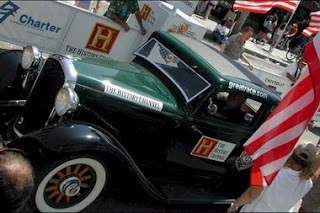 The Finish Line in Pasadena!
The Finish Line in Pasadena!
The cars depart at one-minute intervals and follow very specific instructions (…turn right on Route 27 after a 12-second pause, proceed at 45 miles per hour…). There are unannounced check points on the route where timers record our arrival times. A team is penalized 1 point for every second they arrive early or late at a check point. Incredibly, these old vehicles often have single-digit scores after five or six checkpoints in a given day!
The 2001 route took us from Atlanta eastward to Greenville, South Carolina, then north to Knoxville and Westward to Pasadena. In 2002, it was a short race for the team, since we chose to participate in half the total length. We went from San Antonio to Houston to Dallas to Clovis, New Mexico, to Albuquerque – a very scenic drive.
In 2004, we started in Jacksonville, Florida, proceeding through Florida and Alabama north to Tennessee, then proceeding westward to end in Monterey, California. That was the year Mary Ann and I were dating. She flew out to meet the team the night before the end of the race and rode with the crew into Monterey to witness the finish. It was a great finale, with Tony Curtis there to greet the cars coming in (Recall that he starred in the 1960’s movie, The Great Race.).
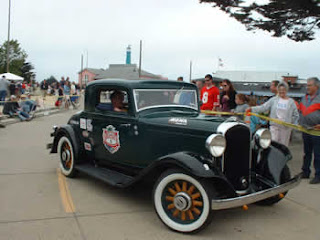 Arriving in Monterey!
Arriving in Monterey!
The 2006 race took us from Philadelphia to San Rafael, California, close to San Francisco. When Bob King asked if I’d like to do the event one more time, I said I didn’t feel like putting the Plymouth (or me crammed in the Plymouth) through that cross-country beating again. He suggested that he might buy a bigger, faster, car. We located the perfect car in Fort Worth, bought it over the phone, flew down to Texas and drove it home!
We’ve had several alternate navigators over the years – Rick Sladek from San Antonio, Jerry Gregg from Huntsville (He got so inspired, he bought a 1957 Chevrolet and did the race with his daughter, Dawn!), and Harry Jenkins from Atlanta.
 The 1936 Buick
The 1936 Buick
In 2006, Mary Ann drove our support vehicle and empty trailer, accompanied by her friend Macie Rorabaugh. They did the real work, getting up and on the road early each day, checking into motels for the whole team, lugging everybody’s luggage up and down stairs, shopping for all the forgotten items. The driver and navigator got to see the country and enjoy a free lunch!
I am not sure if there’s another Great Race in my future. It’s very expensive, even though Bob King has always paid the entry fee of several thousand dollars. It puts a lot of wear and tear on the car and is quite physically demanding. My 6’ 2” frame does not fit well in a 1932 Plymouth! Having said that, I would not rule out any possibility. If the route were particularly appealing, who knows??
 We've had to focus our attention on highly stressful activities -- walks on the beach, shell gathering, jig saw puzzles, dominoes, and food. We gave the oldly-weds a jig saw puzzle that is topographic map with their home in the center of the puzzle. This took us two days of spare time effort:
We've had to focus our attention on highly stressful activities -- walks on the beach, shell gathering, jig saw puzzles, dominoes, and food. We gave the oldly-weds a jig saw puzzle that is topographic map with their home in the center of the puzzle. This took us two days of spare time effort:

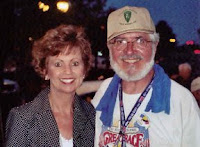
.jpg)
